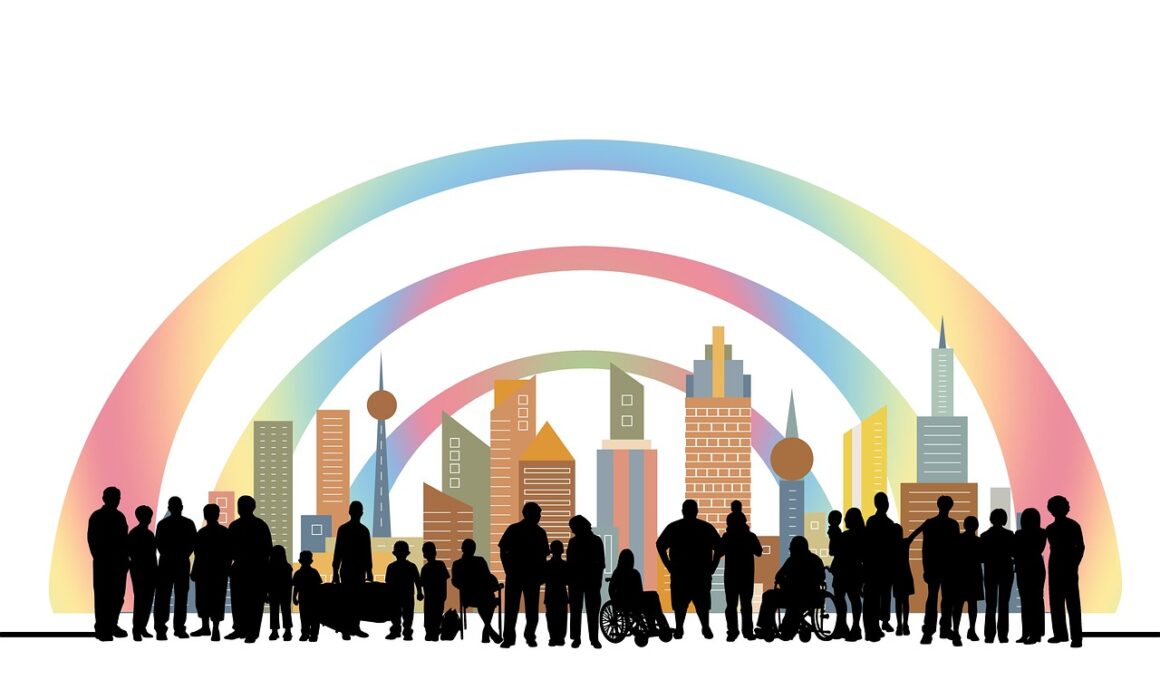Inclusive Fitness Classes: Building Supportive Environments
Inclusive fitness classes play a vital role in the journey towards adaptive fitness for individuals with disabilities. These classes not only welcome participants but also foster an environment where everyone can thrive, regardless of their physical capabilities. By tailoring classes to meet diverse needs, fitness centers can enhance the experiences of individuals requiring special accommodations. Creating supportive environments includes incorporating activities that address various disabilities while encouraging participation. Instructors undergo specialized training to facilitate this inclusivity effectively, ensuring they are equipped with the necessary skills to address each participant’s needs. Building a community that embraces diversity strengthens participants’ self-esteem and promotes camaraderie. Involving participants in class planning fosters a sense of ownership and belonging. Furthermore, inclusive fitness helps in breaking down barriers and stereotypes, proving that physical activity is for everyone. These classes cultivate a culture of mutual support and motivation, encouraging participants to reach their personal fitness goals. The shared experiences often lead to friendships beyond the gym, enriching participants’ social lives. Ultimately, inclusive fitness classes contribute to healthier communities, where everyone has the opportunity to be active and engaged.
The growth of adaptive fitness classes addresses essential factors that promote inclusion for individuals with disabilities. These classes, designed specifically, aim to adapt conventional workout routines, allowing all participants to engage meaningfully. Instructors are trained to recognize barriers and foster supportive connections among participants. This supportive environment is crucial, particularly for individuals with disabilities, as it enables them to explore their limits in a safe space. Adaptive fitness classes integrate creative solutions and modifications, ensuring every person feels valued. Group activities balance individual needs with community spirit, reinforcing the idea that fitness is a collective journey. Developing programs that cater to various abilities can encourage broader participation and highlight each individual’s unique contributions. Customized fitness goals become achievable when support systems are in place, fostering determination and resilience. Local community centers benefit significantly from offering inclusive classes, increasing engagement and connection among members. These classes also emphasize the significance of movement for mental health and physical well-being. Participants often report enhanced mood and decreased anxiety, which further drives individuals to embrace an active lifestyle. Consequently, adaptive fitness classes serve as essential tools for inclusion and empowerment.
Benefits of Inclusive Fitness Classes
Implementing inclusive fitness classes yields numerous benefits for participants, particularly in terms of physical, mental, and social well-being. Individuals engaged in adaptive fitness classes experience increased strength, flexibility, and endurance, ultimately leading to improved overall health. Physical activity is proven to enhance cardiovascular health, increase bone density, and alleviate several chronic conditions. Mental health benefits are equally significant, with many participants reporting reduced anxiety, improved mood, and better stress management. Social interactions within these classes also create valuable connections, reducing feelings of isolation that individuals with disabilities often face. A sense of belonging transforms the gym experience, making it more enjoyable and rewarding. Additionally, inclusive fitness classes encourage healthy competition, motivating participants to challenge themselves alongside others. Participants learn valuable life skills like teamwork and communication, fostering personal growth. They develop a better body image, increase self-esteem, and ignite a passion for exercise that can extend beyond the confines of the class. Establishing friendships in inclusive environments leads to lasting social networks and support systems essential for sustaining an active lifestyle. Ultimately, adaptive fit classes significantly enhance aspects of life for individuals with disabilities, enriching their overall quality of life.
To achieve the goals of inclusivity in fitness environments, certain strategies must be adopted. First, accessibility to facilities is paramount. This includes ensuring that gym layouts are compliant with the Americans with Disabilities Act (ADA), incorporating ramps, wider doorways, and equipment that accommodates various disabilities. Furthermore, specialized fitness equipment should be available, enhancing the ability for participants to engage fully in activities. It is also essential for staff to create an atmosphere of acceptance and openness that can make participants feel at ease. Adequate training for instructors and fitness staff on adaptive methods encourages confidence in handling diverse needs. Regular feedback from participants can guide ongoing improvements in class structure and offerings. Innovative use of technology can provide virtual classes, ensuring individuals who cannot attend in person still have access to workouts that suit their needs. Various resources, such as community organizations and online platforms, can also link individuals with disabilities to adaptive fitness opportunities. Process improvements should remain a continuous goal to keep evolving as community needs change. Establishing partnerships with local health services can enhance physical and mental health support for all participants.
Challenges in Implementing Inclusive Fitness
Despite the clear advantages, including fitness classes face various challenges. One significant barrier is the misconception that adaptive fitness options are limited or do not exist. Awareness and education initiatives are essential to inform individuals, families, and communities about available programs. Many potential participants may not approach gyms due to fears of judgment or lack of suitable accommodations. Hence, fitness centers need to actively promote inclusivity and embrace visibility in their marketing strategies. Instructors also face challenges adapting their teaching styles for varied participants, necessitating continuous training and resources to enhance their skills effectively. Securing funding for inclusive programs often poses a challenge; many facilities operate under tight budgets that prioritize conventional fitness classes. Partnerships with nonprofit organizations and local government can aid in securing necessary funding to support adaptive initiatives. Additionally, fostering a culture of inclusion requires persistent effort and commitment from staff and management. Continuous dialogue within fitness communities about inclusivity sends a strong message valuing everyone, regardless of ability. Addressing and overcoming these challenges ensures that adaptive fitness initiatives can thrive and benefit individuals with disabilities across communities.
Evaluation and feedback mechanisms are necessary to measure the success of inclusive fitness classes. Collecting data on participant engagement and outcomes contributes to understanding their effectiveness. Surveys and informal discussions allow participants to express their experiences, offering insights into what works and what can be improved. These evaluations also help tailor classes to better meet participants’ needs, fostering a culture of adaptability and growth. Moreover, success stories and testimonials can be powerful tools in showcasing the positive impact of inclusive classes. Sharing these narratives helps inspire others to join, dismissing fears and misconceptions surrounding adaptive fitness. Local media outlets, social media platforms, and community events can serve as excellent channels for sharing these encouraging stories. Regularly recognizing participant achievements fosters motivation and encourages commitment within the community. Highlighting individual journeys can change perceptions about disabilities and adaptive fitness, reinforcing that individuals can weather challenges and excel. Moreover, effective evaluations enable fitness facilities to advocate for resources and funding to continue offering inclusive programming. Therefore, consistent assessment and follow-up facilitate the ongoing improvement of inclusive fitness classes, ensuring they remain supportive and impactful for all.
Final Thoughts on Inclusive Fitness
Inclusive fitness classes represent a critical shift in how society views and engages with individuals living with disabilities. Creating environments where everyone is welcomed leads not only to improved physical fitness but also advances social integration and cultural acceptance. By implementing adaptive strategies and practices, fitness centers can bridge the gap between traditional and adaptive fitness programs. It is essential for both participants and instructors to foster a sense of community, where support and motivation flourish. Importantly, individuals with disabilities bring diverse perspectives and strengths, enriching fitness environments by challenging stereotypes. Prioritizing inclusivity is not merely about compliance but about a genuine commitment to creating timeless spaces for everyone. This leads to thriving communities benefiting from individuals’ shared strengths and resilience. As momentum grows surrounding adaptive fitness, more individuals will be inspired to engage actively in their health and wellness journeys. Collaborative efforts among advocates, fitness professionals, and community members are pivotal in furthering adaptive fitness’s prominence in our culture. Ultimately, every step taken towards inclusivity in fitness transforms lives and encompasses the spirit of unity, illustrating that fitness truly is for everyone.
The journey of promoting inclusive fitness remains ongoing, and there is a call to action for all stakeholders. A collective effort is necessary to build strong support systems that ensure adaptive fitness remains a priority within the health and wellness sectors. Collaboration among fitness professionals, healthcare providers, and local governments is crucial to paving the way for innovative adaptations to fitness classes. Future initiatives might focus on enhancing technology support, such as adaptive mobile apps or virtual reality environments that engage individuals with disabilities. Advocacy must continue to broaden awareness of adaptive opportunities and dismantle myths associated with disabilities. Establishing community support networks can empower participants and champions to lead discussions about their experiences. Engaging the wider public can grow community interest and participation in inclusive fitness classes. Additionally, increasing representation of individuals with disabilities in mainstream fitness marketing and programming is critically important for fostering acceptance and understanding. The commitment to adapt and evolve can significantly influence the lives of countless individuals, providing them with pathways to health and well-being. By prioritizing inclusivity, we can ensure that fitness remains a space of empowerment, acceptance, and growth for everyone.


